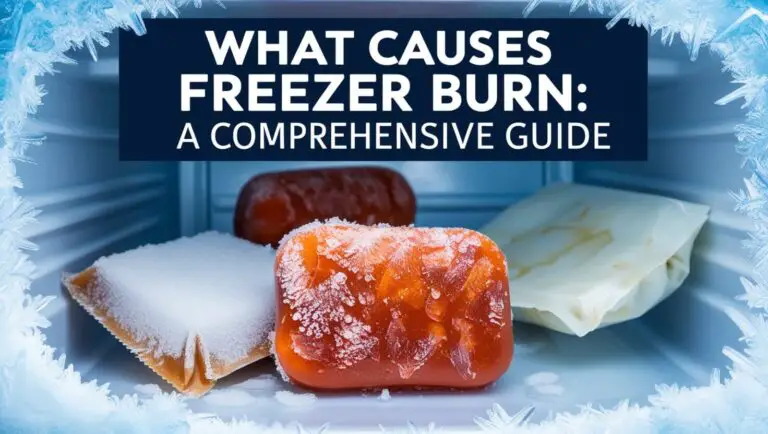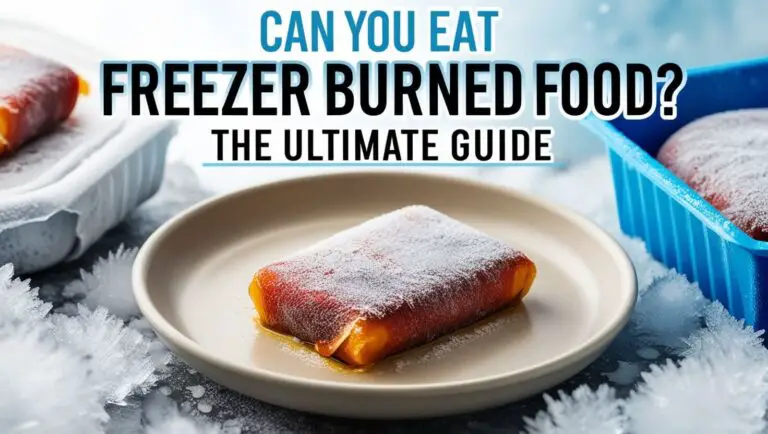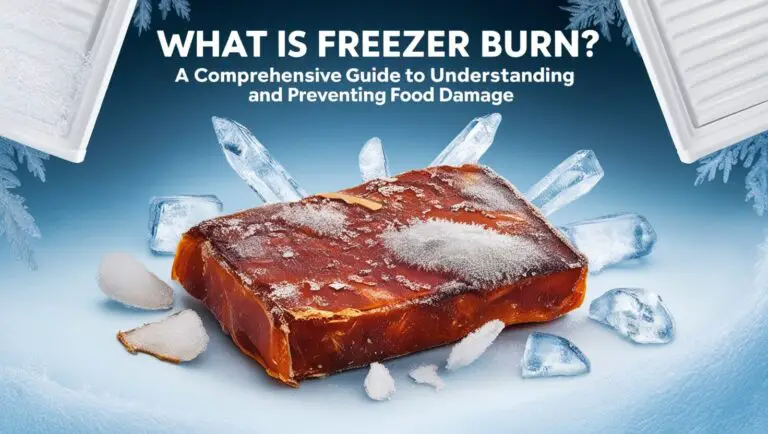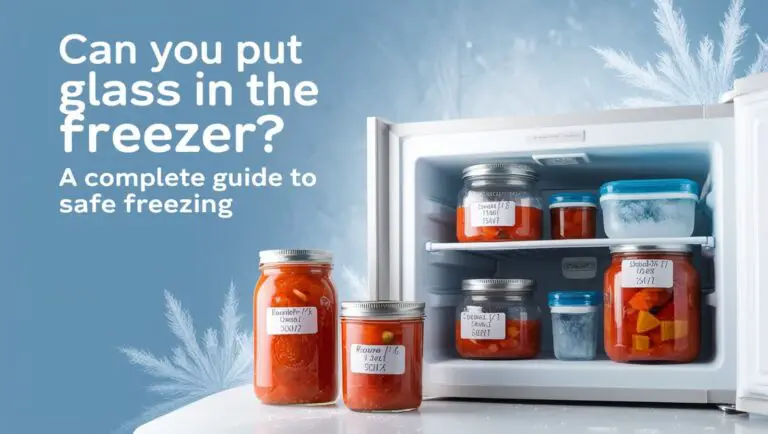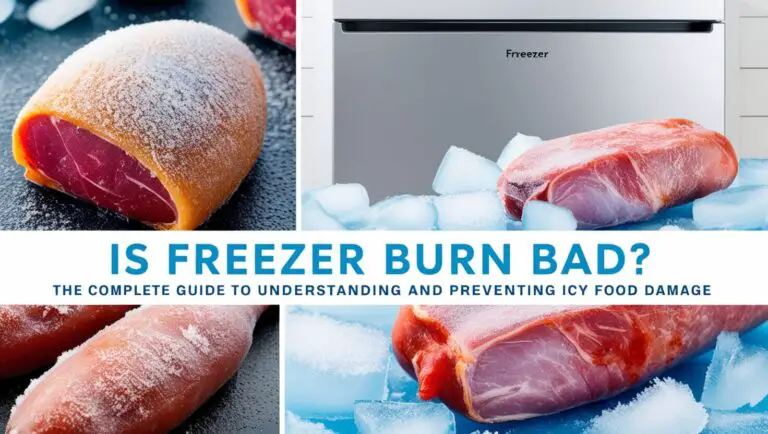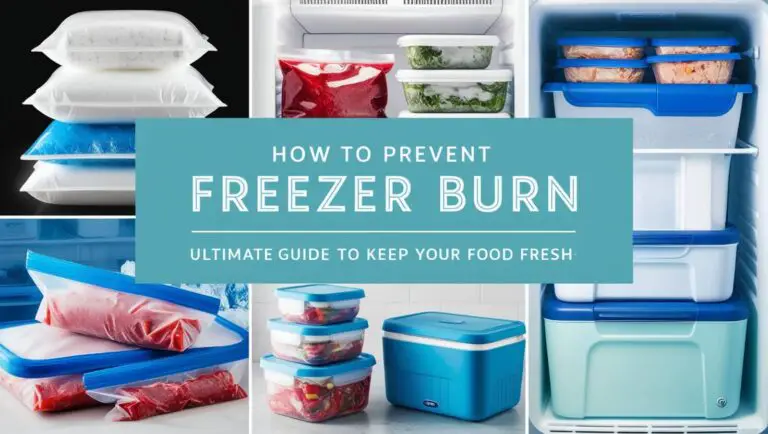What Does Freezer Burn Look Like?
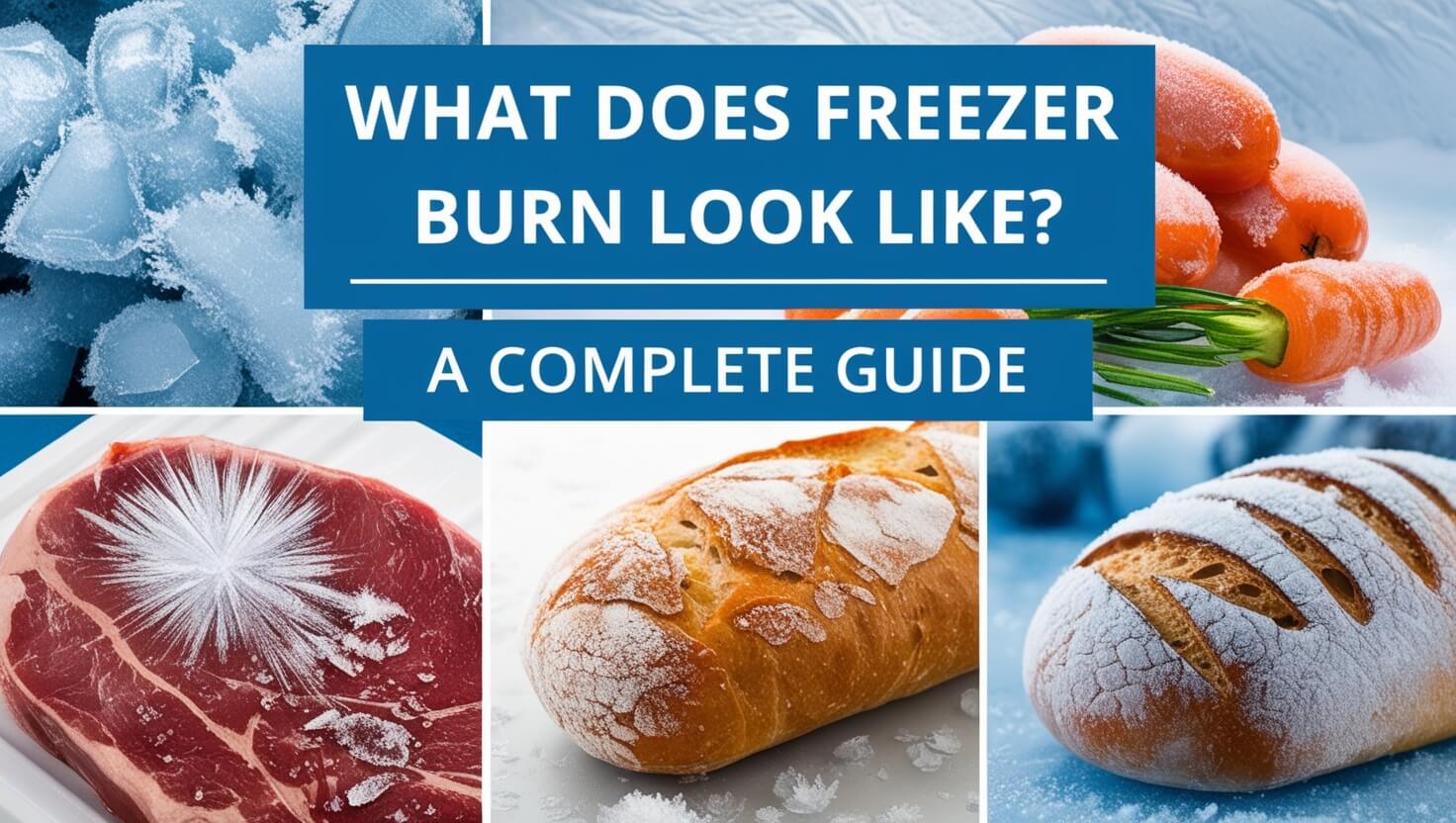
Have you ever pulled something out of your freezer only to find it covered in ice crystals or sporting strange discolored patches? If so, you’ve likely encountered freezer burn. But what exactly does freezer burn look like, and how can you spot it on different foods? In this comprehensive guide, we’ll explore the visual signs of freezer burn, why it happens, and what you can do about it.
Freezer burn appears as discolored, dry patches on frozen foods. It often looks like grayish-brown spots on meat, white or grayish areas on bread, and ice crystals on vegetables or ice cream. While freezer burn affects food quality, it doesn’t make food unsafe to eat.
Understanding Freezer Burn
Before we dive into the visual cues, let’s briefly cover what freezer burn is and why it occurs.
What is Freezer Burn?
Freezer burn is a condition that affects frozen foods when they lose moisture due to exposure to air in the freezer. It’s not a sign of spoilage or bacterial growth, but rather a quality issue that can impact the taste, texture, and appearance of food.
How Does Freezer Burn Occur?
Freezer burn happens when moisture from the food’s surface evaporates into the dry, cold air of the freezer. This process, called sublimation, causes the water in the food to change directly from ice to vapor, bypassing the liquid stage. As moisture leaves the food, it creates dry spots and allows oxygen to penetrate, leading to chemical changes that affect color and flavor.
Is Freezer-Burned Food Safe to Eat?
Yes, freezer-burned food is generally safe to eat. The process doesn’t introduce harmful bacteria or make the food toxic. However, it can significantly impact the quality of the food, making it less enjoyable to consume.
Visual Signs of Freezer Burn
Now that we understand what freezer burn is, let’s explore how it looks on different types of food.
General Appearance of Freezer Burn
Regardless of the food type, freezer burn often shares some common visual characteristics:
- Dry, leathery patches
- Discoloration
- Ice crystals on the surface
- Shriveled or shrunken appearance
Freezer Burn on Different Food Types
Different foods show freezer burn in unique ways. Let’s break it down by food category:
1. Meat and Poultry
On meat and poultry, freezer burn typically looks like:
- Grayish-brown spots on red meat
- Pale, brownish areas on poultry
- Tough, leathery texture in affected areas
- White, dry patches
For example, a freezer-burned steak might have grayish-brown spots that feel tough to the touch, while chicken breasts might develop pale, dry areas on the surface.
2. Fish and Seafood
Freezer burn on fish and seafood often appears as:
- White, dry patches
- Discolored spots that are duller than the surrounding flesh
- A tough, leathery texture in affected areas
A salmon fillet with freezer burn might have white, dry spots that contrast sharply with the pink flesh around it.
3. Fruits and Vegetables
On fruits and vegetables, look for:
- Dry, shriveled areas
- Ice crystals on the surface
- Discolored spots that are duller or darker than the rest of the produce
Freezer-burned strawberries, for instance, might look shrunken and covered in frost, while green beans could have dark, dry patches.
4. Ice Cream and Frozen Desserts
In ice cream and other frozen desserts, freezer burn often shows up as:
- Large ice crystals on the surface
- A gritty, icy texture
- Dry, discolored patches
When you open a tub of freezer-burned ice cream, you might see a layer of large, jagged ice crystals on top, or notice that the once-creamy texture has become grainy and icy.
5. Bread and Baked Goods
Freezer burn on bread and baked goods can look like:
- White or grayish dry spots
- A tougher, more leathery texture in affected areas
- Overall dryness and loss of volume
A loaf of freezer-burned bread might have white, dry patches and feel unusually tough or brittle when thawed.
Identifying Freezer Burn Beyond Visuals
While appearance is the most obvious indicator of freezer burn, there are other ways to identify it:
Texture Changes
Freezer-burned food often feels:
- Tough or leathery in affected areas
- Dry and rough to the touch
- Less pliable than surrounding areas
Odor Indicators
While freezer burn itself doesn’t have a strong odor, severely affected food might smell:
- Slightly stale
- Faintly of plastic (from prolonged exposure to freezer air)
Taste Alterations
If you decide to eat freezer-burned food, you might notice:
- A bland or flavorless taste in affected areas
- A slightly off or stale flavor
- Toughness or dryness when chewing
Factors Affecting Freezer Burn Appearance
Several factors can influence how quickly freezer burn develops and how it looks:
Length of Storage Time
The longer food is stored in the freezer, the more likely it is to develop freezer burn. After about 3-6 months, many foods start showing signs of quality loss.
Packaging Quality
Proper packaging can significantly delay the onset of freezer burn. Foods that are well-wrapped or stored in airtight containers are less likely to show severe signs of freezer burn.
Freezer Temperature Fluctuations
Frequent temperature changes, like those caused by often opening the freezer door, can accelerate freezer burn. Consistent temperatures around 0°F (-18°C) are best for preventing freezer burn.
Air Exposure
The more air a food is exposed to, the faster it will develop freezer burn. This is why tightly wrapped or vacuum-sealed foods tend to resist freezer burn longer.
Preventing Freezer Burn
Now that we know what freezer burn looks like, let’s explore some ways to prevent it:
Proper Packaging Techniques
To minimize air exposure and prevent freezer burn:
- Use freezer-safe, airtight containers
- Wrap foods tightly in plastic wrap or aluminum foil before placing in freezer bags
- Remove as much air as possible from freezer bags before sealing
- Consider using a vacuum sealer for long-term storage
Optimal Freezer Temperature
Maintain your freezer at 0°F (-18°C) or lower. Use a freezer thermometer to monitor the temperature regularly.
Organizing Your Freezer Effectively
Proper organization can help prevent freezer burn by:
- Allowing for better air circulation
- Making it easier to find items quickly, reducing door-open time
- Enabling you to use older items first
Try using clear containers or labeling items clearly to make identification easier.
Labeling and Rotation Strategies
Implement a “first in, first out” system:
- Label all items with the date they were frozen
- Place newer items towards the back of the freezer
- Use older items first to prevent prolonged storage
Dealing with Freezer-Burned Food
If you do encounter freezer burn, all is not lost. Here’s how to handle it:
When to Discard vs. When to Salvage
Generally, you can salvage most freezer-burned foods by:
- Cutting away affected areas on meats and large vegetables
- Using freezer-burned produce in smoothies or cooked dishes
- Mixing freezer-burned ice cream to redistribute ice crystals
However, discard the food if:
- The freezer burn is extensive
- There are signs of spoilage (odd smell, mold)
- The food has been stored for an excessively long time
Tips for Using Freezer-Burned Food
When using freezer-burned food:
- Thaw it in the refrigerator to minimize further moisture loss
- Use it in recipes where texture changes won’t be noticeable (soups, stews, casseroles)
- Add extra seasoning or marinades to compensate for flavor loss
Recipes That Work Well with Slightly Freezer-Burned Ingredients
Some recipes are forgiving of freezer burn:
- Smoothies (for fruits and vegetables)
- Slow-cooker meals (for meats and vegetables)
- Baked goods (for slightly freezer-burned dairy products)
Common Misconceptions About Freezer Burn
Let’s clear up some common misunderstandings about freezer burn:
Freezer Burn vs. Frost
Frost is simply ice that forms on the surface of frozen foods. While it can contribute to freezer burn over time, it’s not the same thing. Frost can often be brushed off, while freezer burn affects the food itself.
Safety Concerns Debunked
Freezer burn doesn’t make food unsafe to eat. It’s a quality issue, not a safety one. However, prolonged freezer storage can mask signs of spoilage, so always check food carefully before consuming.
Impact on Nutritional Value
While freezer burn can affect taste and texture, it doesn’t significantly impact the nutritional value of food. The main nutrients remain intact, even if the food is less palatable.
Freezer Burn in Commercial Foods
Freezer burn isn’t just a home freezer issue. It can affect store-bought frozen foods too.
How to Spot Freezer Burn in Store-Bought Items
Look for:
- Ice crystals inside the packaging
- Discolored or dry spots on the food
- Packages that feel light for their size (indicating moisture loss)
Your Rights as a Consumer
If you purchase severely freezer-burned food:
- You can usually return it to the store for a refund or exchange
- Report it to the store management to help them improve their freezer management
Advanced Tips for Freezer Management
To further prevent freezer burn and maintain food quality:
Choosing the Right Freezer Type
Consider:
- Chest freezers (better for long-term storage due to more stable temperatures)
- Frost-free freezers (convenient but can promote faster freezer burn due to temperature fluctuations)
Using Vacuum Sealers and Other Tools
Invest in:
- Vacuum sealers for removing air from packaging
- Freezer-safe, airtight containers
- High-quality freezer bags
Best Practices for Bulk Freezing
When freezing large quantities:
- Cool foods completely before freezing
- Freeze items in single layers before packaging for long-term storage
- Leave space between items for air circulation during the freezing process
Let’s Finish
Understanding what freezer burn looks like is key to maintaining the quality of your frozen foods. By recognizing the signs early – whether it’s grayish spots on meat, ice crystals on vegetables, or dry patches on bread – you can take steps to prevent further damage and make informed decisions about using or discarding affected items.
Remember, while freezer burn impacts food quality, it doesn’t make food unsafe. With proper packaging, temperature control, and freezer organization, you can significantly reduce the occurrence of freezer burn and enjoy high-quality frozen foods for longer periods.
By applying the knowledge and tips shared in this guide, you’ll be well-equipped to spot, prevent, and deal with freezer burn effectively. Happy freezing!
FAQs About Freezer Burn Appearance
- Q: Can freezer burn happen overnight? A: While unlikely, freezer burn can occur rapidly if food is improperly packaged or exposed to very cold, dry air. However, noticeable freezer burn typically develops over weeks or months.
- Q: Does freezer burn always look the same on all foods? A: No, freezer burn can appear differently depending on the food type. Meats may show discolored patches, while vegetables might look shriveled or have ice crystals.
- Q: Can you reverse the appearance of freezer burn? A: Unfortunately, you can’t reverse freezer burn once it occurs. You can, however, cut away affected areas or use the food in recipes where the texture change won’t be noticeable.
- Q: How quickly does freezer burn typically become visible? A: The timeline varies, but freezer burn can start to become visible within a few weeks to a couple of months, especially on improperly packaged foods.
- Q: Is it normal to see some frost on frozen foods? A: A light frost is normal and not necessarily a sign of freezer burn. However, heavy frost or ice crystals forming directly on the food can indicate the early stages of freezer burn.
- Q: Can vacuum-sealed foods get freezer burn? A: While vacuum-sealing significantly reduces the risk, it doesn’t completely eliminate the possibility of freezer burn. Over very long storage periods, even vacuum-sealed foods can develop some signs of freezer burn.
- Q: Does freezer burn look different on raw vs. cooked foods? A: The basic signs are similar, but cooked foods might show more pronounced texture changes and discoloration due to their altered structure compared to raw foods.

